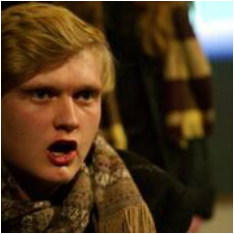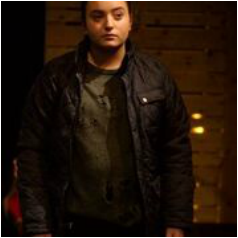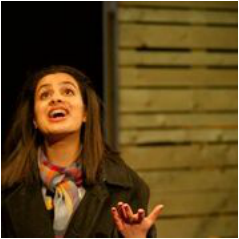Project J: The Holding Place
The SettingProject J is one of York Theatre Royal’s youth theatres for 14-16-year-olds. The members are largely confident young actors, and the group has a supportive, playful and enthusiastic atmosphere.
Starting PointThe group’s lead practitioner Matt Harper had accepted the commission of the head of the youth theatre to devise a play in response to the recent refugee crisis. On first presenting this challenge to the group he was met with great apprehension, as the young people were concerned about misrepresenting the painful stories of refugees. They were fearful too of the issue’s political complexity. I proposed that I join him as storyteller and assistant for the 6-month devising and writing period, and that we use a section of the classic myth of refuge, the Aeneid, as a container and starting point for devising. The group responded intelligently to my initial telling of the story, and were themselves drawn to the idea of weaving together reality and myth, although it was not immediately apparent to them how this might be done.
DevelopmentsOver the following six weeks we invited people with personal experience of refugee camps to talk to the group, and identified numerous resonances between their stories and elements of the story of Dido and Aeneas. I led workshops exploring the different forms of love expressed in the myth, its physical and emotional geography, and the complex character of Dido in particular. Matt led workshops on the dynamics of gift-giving, and the objects which would express refugees’ yearning for both their old and new homes. To all these workshops we brought a long roll of lining paper on which the young people recorded their observations and reflections.
|
Key themes that emerged between the myth and the true stories included the loss of a sense of time in the ‘holding place’ of a refugee camp, the importance of ‘little gifts’ and encounters that bring comfort, the variously hostile and friendly welcomes of the local populace, the attempt to recreate hospitality and community, the different kinds of leadership that make life liveable, and the idea of a personal or family destiny. Just before Christmas 2015 we sat around this huge document and the young people generated ideas for a fictional story around these themes. After Matt and I developed these ideas into a detailed plot, he wrote the script and I the songs for a play we called ‘The Holding Place’. This was performed throughout the spring at York St John University, the ‘Storyknowing’ symposium and festival, and YSJ’s ‘Create’ Festival. It centred on a temporary community of refugees who told and enacted the story of Dido and Aeneas as a way of making sense of their current troubles, and a young aid worker whose worldview was challenged by their apparently fatalistic attitude. The political divisions surrounding the refugee crisis were given full expression through the voices of the aid worker’s friends, and the play did not attempt to provide answers to these large-scale questions. Rather, as in the myth, conflicting perspectives were allowed to confront each other. Endings and LearningsThe young people’s reflections on the process, in a Q&A session after the final performance, were that they had indeed done justice to the stories they had heard, despite their initial anxieties. The ‘distant’ nature of the myth had provided them with a landscape within which they could play with ideas without the requirement to attain fidelity to any individual story. They emphasised that they understood the complexity of the refugee crisis, but that in the play they were trying to show that common humanity must be the starting point.
|
Discussion Pathways
Blog post:
- 'Whose story is it?' - exploring the developmental and generational roots of young people's reluctance to 'play fast and loose' with the stories of others.


